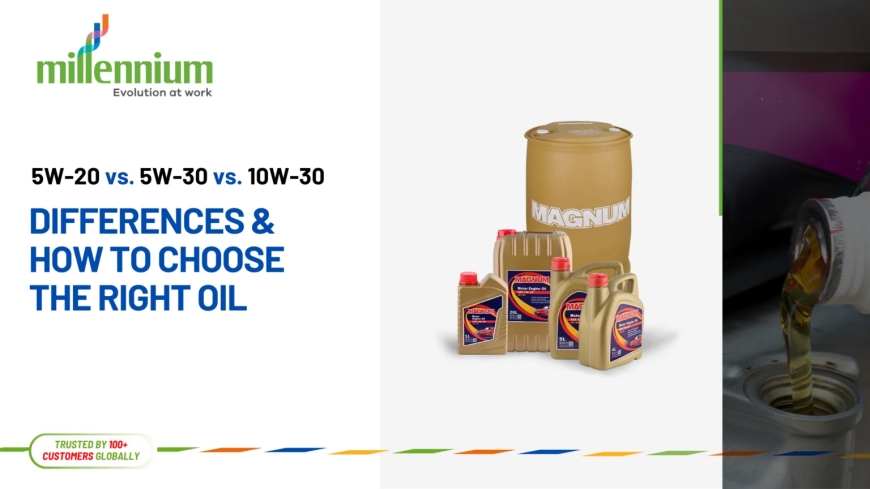5W-20 Vs 5W-30 Vs 10W-30: Differences & How to Choose the Right Oil
Understanding the differences between 5W-20, 5W-30, and 10W-30 engine oils helps you make a smarter choice for your vehicle’s maintenance.

Understanding Engine Oil Grades
Engine oil is a vital fluid that lubricates the internal components of your engine, reduces friction, carries away heat, and protects against corrosion and wear. Choosing the right engine oil is essential to maintain engine performance and longevity. However, with so many oil grades availablesuch as 5w 20 vs 5w 30 vs 10w 30its important to understand what these labels mean and how to determine the best fit for your vehicle.
What Do the Numbers and Letters Mean?
The SAE (Society of Automotive Engineers) grading system is used to classify motor oils based on their viscosity characteristics. In a label like 5W-30:
-
The first number (5W) indicates the oils viscosity in cold temperatures (W stands for winter). The lower this number, the better the oil flows in cold starts.
-
The second number (30) reflects the oils viscosity at high engine operating temperatures. A higher number means the oil remains thicker at high heat, providing better protection.
So, 5W-20, 5W-30, and 10W-30 are all multi-grade oils that behave differently under varying temperature conditions.
Why Viscosity Matters for Your Engine
Viscosity determines how well the oil flows in your engine. If the oil is too thin at high temperatures, it may not provide enough lubrication, leading to increased engine wear. On the other hand, if its too thick during cold starts, it may not circulate quickly enough to protect moving parts.
Using the right viscosity grade:
-
Enhances engine performance
-
Improves fuel economy
-
Reduces wear and tear
-
Ensures proper start-up lubrication in cold weather
What is 5W-20 Oil?
5W-20 is a low-viscosity engine oil formulated to flow quickly in cold conditions while maintaining a thin consistency at operating temperatures. It's ideal for:
-
Cold climates
-
Modern engines with tighter tolerances
-
Vehicles designed for fuel efficiency
Benefits:
-
Better fuel economy due to reduced internal friction
-
Faster oil circulation during cold starts
-
Recommended by many manufacturers for newer cars
However, it may not offer enough protection in extremely hot conditions or under heavy engine loads.
What is 5W-30 Oil?
5W-30 is one of the most commonly used motor oils. It provides a balance between low-temperature performance and high-temperature protection.
Best suited for:
-
A wide range of temperatures (moderate climates)
-
Light-duty trucks, SUVs, and passenger cars
-
Both city and highway driving
Benefits:
-
Good cold start performance
-
Thicker at operating temperatures than 5W-20, offering better protection for older engines or those driven in warmer conditions
This oil is versatile and widely recommended by automakers.
What is 10W-30 Oil?
10W-30 has a slightly higher cold viscosity than 5W oils, which means its not as effective during extremely cold starts but offers robust protection at higher temperatures.
Ideal for:
-
Warmer climates
-
High-mileage engines or those that run hotter
-
Older vehicles or those used for towing and hauling
Benefits:
-
Thicker film strength at higher operating temperatures
-
Better suited for engines that experience greater stress
This oil is commonly used where cold weather is not a concern.
Comparing 5W-20, 5W-30, and 10W-30
| Feature | 5W-20 | 5W-30 | 10W-30 |
|---|---|---|---|
| Cold Start | Excellent | Excellent | Good |
| High Temp Protection | Moderate | Good | Very Good |
| Fuel Efficiency | High | Moderate | Lower |
| Ideal Climate | Cold to mild | Cold to warm | Warm |
| Engine Type | Newer engines | Modern engines | Older or high-load engines |
Each oil has its own strengths, and using the wrong one can affect engine erformance, wear, and fuel economy.
How to Choose the Right Oil for Your Vehicle
Choosing the correct engine oil grade involves considering a few important factors:
-
Manufacturers Recommendation
Always refer to your vehicle owners manual. The manufacturer has tested the engine and recommends a specific oil grade that ensures optimum performance and protection. -
Climate and Driving Conditions
-
In cold climates, opt for oils with lower W numbers (e.g., 5W).
-
In hotter environments, oils with higher viscosity at operating temperature (like 10W-30) provide better protection.
-
-
Engine Age and Mileage
-
Newer engines may perform best with 5W-20 or 5W-30.
-
High-mileage engines might benefit from the slightly thicker 10W-30 to reduce oil consumption and improve sealing.
-
-
Driving Habits
-
For short trips or city driving, lighter oils improve fuel efficiency.
-
For towing or long highway drives, heavier oils offer greater protection.
-
-
Fuel Economy Needs
If fuel economy is a priority, 5W-20 may offer a small advantage over 5W-30 or 10W-30.
Conclusion
Understanding the differences between 5W-20, 5W-30, and 10W-30 engine oils helps you make a smarter choice for your vehicles maintenance. While all three offer excellent lubrication, their performance varies with temperature, driving conditions, and engine requirements.
When in doubt, always follow your manufacturers recommendation, consider your local climate, and match your oil choice to your driving habits. The right engine oil not only improves performance but also extends the life of your engine, reduces emissions, and enhances overall driving efficiency.








































